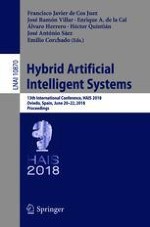2018 | Buch
Hybrid Artificial Intelligent Systems
13th International Conference, HAIS 2018, Oviedo, Spain, June 20-22, 2018, Proceedings
herausgegeben von: Francisco Javier de Cos Juez, José Ramón Villar, Enrique A. de la Cal, Álvaro Herrero, Héctor Quintián, José António Sáez, Emilio Corchado
Verlag: Springer International Publishing
Buchreihe : Lecture Notes in Computer Science
